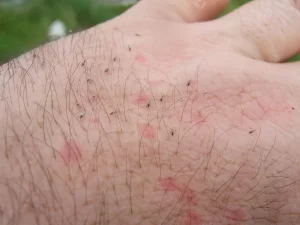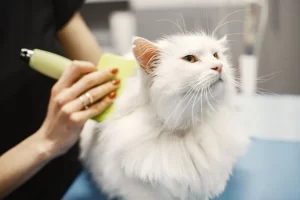As a cat owner, it’s not uncommon to notice unusual changes in your furry friend’s coat or skin. One concerning issue that many cat owners may face is when their cat has patches of fur missing and sores. This can be a sign of various skin problems that can range from mild to severe, and it’s important to identify the underlying cause and provide proper treatment. In this article, we’ll discuss common causes of skin problems in cats, how to identify symptoms, and various treatment options, including medications, home remedies, dietary changes, parasite control, and grooming techniques. We’ll also cover preventative measures to reduce the risk of skin problems and potential long-term management of these conditions.
Table of Contents
ToggleCommon Causes of Patches of Missing Fur and Sores on Cats
There are several common causes of patches of missing fur and sores on cats, including:
- Fleas and other parasites: Fleas, mites, and other parasites can cause skin irritation, leading to scratching and biting, which can result in missing fur and sores.
- Allergies: Cats can develop allergies to a variety of substances, such as food, pollen, and dust mites. Allergies can cause skin inflammation, itching, and scratching, which can lead to missing fur and sores.
- Fungal and bacterial infections: Cats can develop infections on their skin, which can cause redness, irritation, and hair loss. Fungal infections, such as ringworm, and bacterial infections, such as pyoderma, are common in cats.
- Stress and anxiety: Cats can develop stress and anxiety, which can cause them to over-groom and excessively lick themselves, leading to hair loss and sores.
- Hormonal imbalances: Cats can develop hormonal imbalances, such as hyperthyroidism or Cushing’s disease, which can cause hair loss and skin problems.
- Trauma: Cats can experience physical trauma, such as injuries or burns, which can lead to missing fur and sores.
- Skin cancer: While less common, skin cancer can also cause patches of missing fur and sores on cats.
Symptoms of Skin Problems in Cats
Skin problems in cats can present with a variety of symptoms, including:
- Patches of missing fur: This is one of the most common symptoms of skin problems in cats. The patches may be small or large, and may be accompanied by redness, swelling, or sores.
- Itching and scratching: Cats with skin problems may itch and scratch themselves excessively, leading to further skin irritation and hair loss.
- Redness and inflammation: Skin problems in cats can cause redness and inflammation, which may be localized or widespread.
- Sores and scabs: Skin problems can cause sores and scabs on the cat’s skin. These may be open and weeping or dry and crusty.
- Dry or oily skin: Cats with skin problems may have skin that is dry, flaky, and prone to dandruff, or oily and greasy.
- Foul odor: In some cases, skin problems can cause a foul odor, which may be due to bacterial or fungal infections.
- Behavioral changes: Cats with skin problems may become more irritable or anxious due to the discomfort and pain associated with their skin condition.
To identify skin problems in cats, it is important to regularly examine their skin and fur for any changes or abnormalities. Look for areas of missing fur, redness, swelling, or sores. Also, observe the cat’s behavior for signs of excessive scratching or licking.
Treatment Options for Skin Problems in Cats
Treatment options for skin problems in cats will vary depending on the underlying cause and severity of the condition. Here are some of the treatment options that a veterinarian may recommend:
- Medications: Depending on the cause of the skin problem, medications may be prescribed. For example, antibiotics may be prescribed to treat bacterial infections, antifungal medications for fungal infections, and corticosteroids or antihistamines for allergies.
- Topical treatments: Topical treatments, such as medicated shampoos, sprays, and creams, may also be used to treat skin problems. These products can help to reduce inflammation, itching, and prevent further infections.
- Parasite control: If parasites, such as fleas or mites, are the cause of the skin problem, treatment to control and eliminate these pests is essential. This may include flea and tick prevention medications, as well as environmental control measures, such as vacuuming and washing bedding.
- Dietary changes: In some cases, dietary changes may be recommended to improve the cat’s skin health. This may involve switching to a hypoallergenic or prescription diet, which can help to reduce the risk of allergic reactions.
- Home remedies: There are some home remedies that may help to alleviate skin problems in cats. For example, adding omega-3 fatty acids to the cat’s diet can help to reduce inflammation and improve skin health. Additionally, colloidal oatmeal baths can help to soothe irritated skin.
Managing Parasites in Cats: Home Remedies and Prevention Tips
It is important to note that while there are some home remedies and over-the-counter products that can help to control parasites in cats, it is always recommended to consult with a veterinarian before starting any treatment. Parasite control is an important part of maintaining a cat’s overall health, as parasites can cause a range of health problems, including skin problems, anemia, and disease transmission.
Here are some common parasites in cats and some home remedies that can be used to manage them:
- Fleas: Fleas are one of the most common parasites in cats. To control fleas at home, you can use a flea comb to remove adult fleas and their eggs from the cat’s fur. Additionally, you can sprinkle diatomaceous earth on carpets and bedding, which can help to kill fleas and their larvae.
- Ticks: Ticks can transmit a variety of diseases to cats and humans, making it important to control them. To remove ticks at home, use a pair of tweezers to grasp the tick as close to the skin as possible and pull straight out. Avoid squeezing the tick or twisting it, as this can cause the head to remain in the skin.
- Ear mites: Ear mites are a common parasite that live in the ear canals of cats. To control ear mites, you can use a mixture of equal parts water and apple cider vinegar to clean the cat’s ears. Apply the solution to a cotton ball and gently wipe the inside of the ear canal.
- Roundworms: Roundworms are a type of intestinal parasite that can be passed from cats to humans. To control roundworms, it is important to practice good hygiene, such as washing your hands after handling the cat and cleaning the litter box regularly. Additionally, you can give the cat a deworming medication, which is available over-the-counter at pet stores.
Feline Skin Care: Dietary and Supplement Options
Dietary changes and supplements can play an important role in managing skin problems in cats. Here are some dietary changes and supplements that may be recommended:
- Omega-3 Fatty Acids: Omega-3 fatty acids can help to reduce inflammation and improve skin health in cats. These fatty acids can be found in fish oil supplements, as well as in foods such as salmon and sardines.
- Hypoallergenic Diet: In some cases, skin problems in cats may be caused by food allergies. A hypoallergenic diet, which is formulated to exclude common allergens such as beef, chicken, and dairy, may be recommended to help manage the condition.
- Digestive Enzymes and Probiotics: Digestive enzymes and probiotics can help to improve digestion and reduce inflammation in cats with skin problems. These supplements can be found in pet stores or online and should be given under the guidance of a veterinarian.
- Vitamin E: Vitamin E is an antioxidant that can help to improve skin health in cats. This vitamin can be found in foods such as almonds, sunflower seeds, and spinach, or in supplement form.
- Zinc: Zinc is a mineral that is essential for skin health. It can be found in foods such as beef, chicken, and turkey, or in supplement form.
Home Remedies for Cats with Patches of Missing Fur and Sores
While it is always recommended to consult with a veterinarian before starting any treatment, there are some home remedies that can help to manage skin problems and parasites in cats. Here are some examples:
- Coconut Oil: Coconut oil can help to soothe itchy skin and reduce inflammation in cats. Apply a small amount of coconut oil to the affected area and massage it into the skin.
- Aloe Vera: Aloe vera gel can be applied topically to soothe irritated skin and promote healing. Simply apply a small amount of aloe vera gel to the affected area and massage it into the skin.
- Apple Cider Vinegar: Apple cider vinegar can help to control fleas and reduce inflammation in cats with skin problems. Mix equal parts apple cider vinegar and water, and apply the solution to a cotton ball. Wipe the cotton ball over the cat’s skin, taking care to avoid the eyes and nose.
- Chamomile Tea: Chamomile tea can be used as a natural rinse to soothe irritated skin in cats. Steep chamomile tea bags in boiling water for several minutes, then allow the tea to cool. Pour the cooled tea over the cat’s skin and allow it to air dry.
- Epsom Salt: Epsom salt can help to reduce inflammation and promote healing in cats with skin problems. Add a small amount of Epsom salt to warm water, and soak the affected area for several minutes.
No More Missing Fur and Sores: Preventative Measures for Cat Skin Health
Preventative measures can help to reduce the risk of skin problems in cats. Here are some tips to help keep your cat’s skin healthy:
- Regular grooming: Regular grooming can help to remove loose hair and dirt, which can contribute to skin problems in cats. Brush your cat’s fur at least once a week to help keep their skin healthy and clean.
- Regular bathing: Bathing your cat can help to remove dirt and debris from their skin and coat. Use a mild cat shampoo, and avoid bathing your cat more than once a month to prevent drying out their skin.
- Parasite prevention: Parasites such as fleas and ticks can cause skin problems in cats. Use a monthly flea and tick preventative, and check your cat for parasites regularly.
- Good nutrition: Feeding your cat a balanced, high-quality diet can help to promote healthy skin and a shiny coat. Choose a diet that is appropriate for your cat’s age and health needs, and avoid overfeeding to prevent obesity.
- Environmental management: Environmental factors such as pollen, dust, and mold can contribute to skin problems in cats. Keep your home clean and dust-free, and use an air purifier to help reduce allergens in the air.
- Regular veterinary check-ups: Regular veterinary check-ups can help to identify skin problems early, before they become more serious. Schedule an annual check-up with your veterinarian, and bring your cat in for an exam if you notice any changes in their skin or coat.
Grooming Techniques for Cats with Skin Problems
Grooming techniques for cats with skin problems can help to keep their skin clean and healthy. Here are some tips for grooming cats with skin problems:
- Use a soft-bristled brush: Use a soft-bristled brush to avoid causing any further irritation to your cat’s skin. Brush your cat’s fur gently to remove any loose hair or dirt.
- Use a flea comb: A flea comb can help to remove fleas and flea dirt from your cat’s coat. Comb your cat’s fur with a flea comb, paying close attention to areas where fleas are most likely to hide, such as around the neck and tail.
- Clean your cat’s ears: Clean your cat’s ears regularly to prevent ear infections. Use a cotton ball or soft cloth to clean the inside of your cat’s ears, taking care not to push any debris further into the ear canal.
- Bathe your cat: Bathing your cat can help to remove dirt and debris from their skin and coat. Use a mild cat shampoo, and avoid bathing your cat more than once a month to prevent drying out their skin.
- Keep your cat’s skin moisturized: Use a moisturizing spray or lotion to keep your cat’s skin hydrated and healthy. Apply the moisturizer to your cat’s skin after bathing or grooming, taking care to avoid the eyes and nose.
- Trim your cat’s nails: Long nails can scratch and irritate your cat’s skin. Trim your cat’s nails regularly to keep them short and prevent any damage to their skin.
By following these grooming techniques, you can help to keep your cat’s skin clean and healthy.
Potential Complications of Skin Problems in Cats
Skin problems in cats can range from mild irritations to more serious conditions that require long-term management. Here are some potential complications and long-term management options for cats with skin problems:
- Infection: Skin problems in cats can lead to bacterial or fungal infections. If left untreated, these infections can become more serious and spread to other areas of the body. Your veterinarian may prescribe antibiotics or antifungal medications to treat these infections.
- Allergies: Skin problems in cats can be caused by allergies to food, fleas, environmental allergens, or other factors. If your cat has allergies, your veterinarian may recommend allergy testing and allergy shots to help manage their symptoms.
- Chronic skin conditions: Some cats may develop chronic skin conditions such as atopic dermatitis or autoimmune skin diseases. These conditions require long-term management and may include a combination of medications, dietary changes, and lifestyle modifications.
- Secondary complications: Cats with skin problems may develop secondary complications such as hair loss, scabs, or wounds. These complications can make it more difficult for your cat to groom themselves, leading to further skin problems.
Frequently Asked Questions (FAQs) about Skin Problems in Cats
Can stress cause skin problems in cats?
Yes, stress can weaken a cat’s immune system and lead to skin problems.
Can indoor cats get fleas?
Yes, indoor cats can still get fleas if they come into contact with other animals that have fleas.
Can I use human shampoo on my cat?
No, human shampoo is not safe for cats and can cause skin irritation.
How often should I bathe my cat with skin problems?
You should bathe your cat with skin problems no more than once a month to prevent drying out their skin.
How can I prevent my cat from getting skin problems?
You can prevent your cat from getting skin problems by maintaining good hygiene, providing a balanced diet, and taking preventative measures against parasites.
Can cats develop skin cancer?
Yes, cats can develop skin cancer, especially those with white or light-colored fur.
Can certain foods cause skin problems in cats?
Yes, some cats may develop skin problems due to food allergies or sensitivities.
Can I give my cat supplements to help with their skin problems?
Yes, some supplements such as omega-3 fatty acids may help improve a cat’s skin and coat health.
How can I tell if my cat’s skin problem is serious?
If your cat’s skin problem does not improve with home care or is accompanied by other symptoms such as fever or lethargy, it may be a sign of a more serious condition and you should consult with a veterinarian.
Can cats get sunburned?
Yes, cats with light-colored fur or areas of thin fur are more susceptible to sunburn.
Can cats get ringworm?
Yes, ringworm is a common fungal infection that can affect cats.
Can I use essential oils on my cat’s skin?
No, essential oils can be toxic to cats and should not be used on their skin.
Can cats develop acne?
Yes, some cats may develop acne on their chins or around their mouths.
How can I tell if my cat has ear mites?
Symptoms of ear mites in cats include shaking of the head, scratching at the ears, and a buildup of dark wax in the ear canal.
Can cats develop skin problems due to a weakened immune system?
Yes, cats with a weakened immune system may be more susceptible to skin problems.
Can I use over-the-counter medications on my cat’s skin problems?
No, over-the-counter medications may be harmful to cats and should only be used under the guidance of a veterinarian.
How can I prevent my cat from scratching their skin problems?
You can prevent your cat from scratching their skin problems by using an Elizabethan collar or other types of protective clothing.
Can cats get skin infections from grooming tools?
Yes, dirty or contaminated grooming tools can cause skin infections in cats.
Can I use a hairdryer to dry my cat after a bath?
No, hairdryers can be too hot for cats and may burn their skin. Instead, use a towel to dry your cat.
Can cats develop skin problems due to exposure to toxins?
Yes, exposure to toxins such as pesticides or cleaning chemicals can cause skin problems in cats














